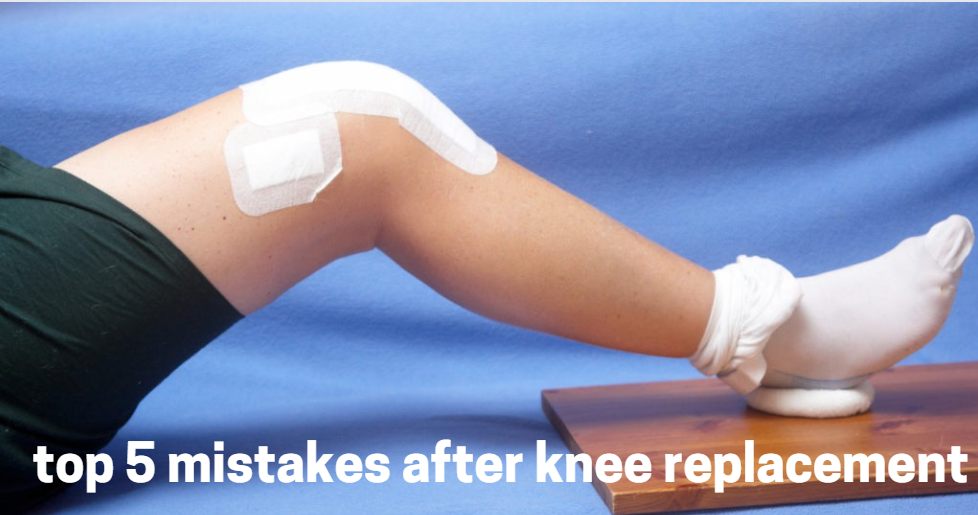Knee replacement surgery, also known as knee arthroplasty, is a common and effective procedure for individuals suffering from severe knee pain and limited mobility due to arthritis or injury. While the surgery itself can significantly improve quality of life, the recovery process is critical to achieving the best possible outcome.
Unfortunately, many patients make mistakes during their recovery that can hinder their progress or even lead to complications. This article will delve into the top 5 mistakes after knee replacement and provide valuable insights and advice to help you avoid them, ensuring a smoother and more successful recovery.
Contents
- 1 Understanding Knee Replacement Surgery
- 2 The Top 5 Mistakes After Knee Replacement
- 3 Expert Insights and Tips for a Successful Recovery
- 4 Commonly Asked Questions (FAQs)
- 4.1 What are the most common mistakes after knee replacement surgery?
- 4.2 How can I manage pain and swelling after knee replacement surgery?
- 4.3 Why is physical therapy important after knee replacement surgery?
- 4.4 How soon can I resume normal activities after knee replacement surgery?
- 4.5 What should I do if I experience complications after knee replacement surgery?
- 5 Conclusion
Understanding Knee Replacement Surgery
What is Knee Replacement Surgery?
Knee replacement surgery involves removing damaged cartilage and bone from the knee joint and replacing it with artificial components made of metal and plastic. This procedure is typically recommended for individuals with severe osteoarthritis, rheumatoid arthritis, or traumatic injury that has not responded to conservative treatments.
Importance of Proper Recovery
Recovery from knee replacement surgery is a gradual process that requires patience, dedication, and adherence to medical advice. Proper recovery is crucial for:
- Reducing pain and swelling
- Restoring mobility and strength
- Preventing complications
- Ensuring the longevity of the knee implant
The Top 5 Mistakes After Knee Replacement
1. Avoiding Movement
Why Movement is Essential
One of the most common mistakes after knee replacement surgery is avoiding movement. While it may seem counterintuitive, staying active is essential for a successful recovery. Movement helps:
- Improve blood circulation
- Reduce swelling
- Prevent stiffness and scar tissue formation
- Strengthen muscles around the knee
How to Incorporate Safe Movement
Start with gentle exercises as recommended by your physical therapist. Activities such as walking, leg lifts, and knee bends can help maintain mobility and promote healing. Gradually increase the intensity and duration of your exercises as your recovery progresses.
2. Doing Too Much Too Soon
The Risks of Overexertion
While movement is crucial, doing too much too soon can be detrimental. Overexertion can lead to increased pain, swelling, and even injury to the new joint. It’s important to strike a balance between activity and rest.
Guidelines for Safe Activity Levels
Follow your surgeon’s and physical therapist’s guidelines for activity levels. Listen to your body and avoid pushing yourself too hard. It’s better to progress slowly and steadily rather than risk setbacks by overdoing it.
3. Neglecting Physical Therapy
The Role of Physical Therapy in Recovery
Physical therapy plays a vital role in the recovery process after knee replacement surgery. A structured physical therapy program helps:
- Improve range of motion
- Strengthen muscles
- Enhance balance and coordination
- Speed up the recovery process
How to Stay Committed to Physical Therapy
Attend all scheduled physical therapy sessions and perform prescribed exercises at home. Communicate with your therapist about any concerns or difficulties you encounter. Staying committed to your therapy plan is key to a successful recovery.
4. Ignoring Pain and Swelling
Understanding Post-Surgical Pain and Swelling
Pain and swelling are common after knee replacement surgery, but ignoring these symptoms can lead to complications. Proper pain management and addressing swelling are essential for a smooth recovery.
Effective Pain and Swelling Management Techniques
Follow your surgeon’s recommendations for pain management, which may include medications, ice therapy, and elevation. Use ice packs to reduce swelling and keep your leg elevated as much as possible. Consistent pain and swelling management will help you stay comfortable and aid the healing process.
5. Skipping Follow-Up Appointments
Importance of Regular Check-Ups
Regular follow-up appointments with your surgeon are crucial to monitor your progress and address any potential issues. Skipping these appointments can result in unrecognized complications or delayed intervention.
Staying on Track with Your Recovery
Attend all scheduled follow-up appointments and discuss any concerns or symptoms with your surgeon. These check-ups are an opportunity to assess your recovery, adjust your treatment plan if necessary, and ensure that you are on the right track.
Expert Insights and Tips for a Successful Recovery
Tips from Orthopedic Surgeons
Orthopedic surgeons emphasize the importance of following post-surgical guidelines and staying proactive in your recovery. Here are some expert tips:
- Stay Hydrated: Drinking plenty of water aids in overall recovery and helps manage swelling.
- Maintain a Healthy Diet: Proper nutrition supports healing and provides the energy needed for physical activity.
- Use Assistive Devices: Use crutches, walkers, or canes as recommended to avoid putting unnecessary strain on your new knee.
Real-Life Patient Experiences
Hearing from individuals who have undergone knee replacement surgery can provide valuable insights and encouragement. Here are some real-life patient experiences:
- John’s Story: “I was hesitant to move after surgery, but my physical therapist encouraged me to start with small steps. Gradually, I regained my strength and mobility.”
- Mary’s Journey: “I tried to do too much too soon, thinking it would speed up my recovery. Instead, it set me back. Listening to my body and following my therapist’s advice made all the difference.”
Commonly Asked Questions (FAQs)
What are the most common mistakes after knee replacement surgery?
The most common mistakes include avoiding movement, doing too much too soon, neglecting physical therapy, ignoring pain and swelling, and skipping follow-up appointments.
How can I manage pain and swelling after knee replacement surgery?
Follow your surgeon’s recommendations for pain management, which may include medications, ice therapy, and elevation. Use ice packs to reduce swelling and keep your leg elevated as much as possible.
Why is physical therapy important after knee replacement surgery?
Physical therapy is crucial for improving range of motion, strengthening muscles, enhancing balance and coordination, and speeding up the recovery process.
How soon can I resume normal activities after knee replacement surgery?
The timeline for resuming normal activities varies for each individual. Follow your surgeon’s and physical therapist’s guidelines for safe activity levels and progress gradually.
What should I do if I experience complications after knee replacement surgery?
Contact your surgeon immediately if you experience any complications, such as increased pain, swelling, redness, or difficulty moving your knee. Regular follow-up appointments can help monitor your progress and address any issues early on.
Conclusion
Recovering from knee replacement surgery requires a balanced approach that includes movement, rest, physical therapy, and proper pain management. Avoiding common mistakes such as avoiding movement, overexertion, neglecting therapy, ignoring symptoms, and skipping appointments can significantly impact your recovery.
By following expert advice, staying committed to your recovery plan, and being proactive in your care, you can achieve the best possible outcome and enjoy a more active and pain-free life.



